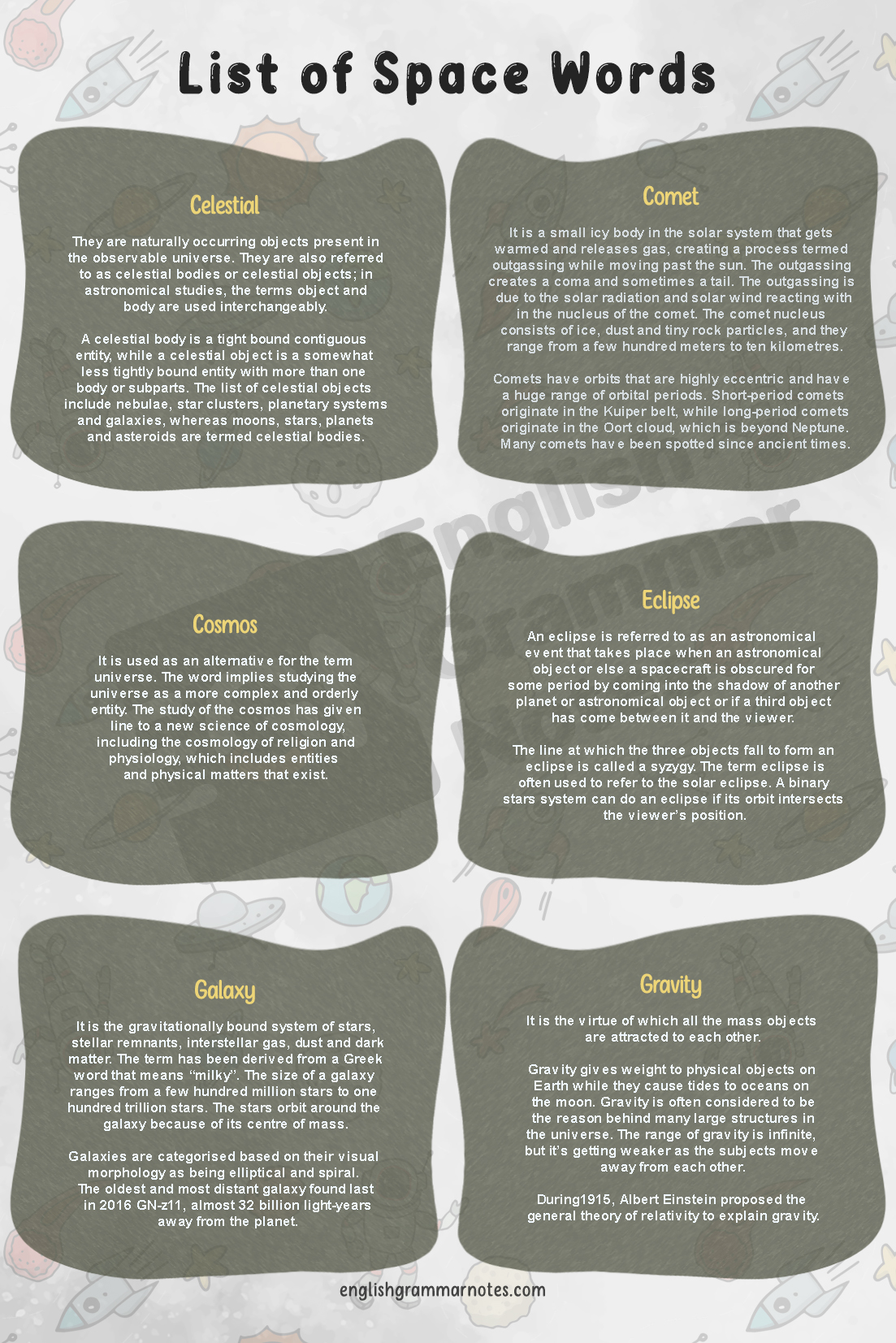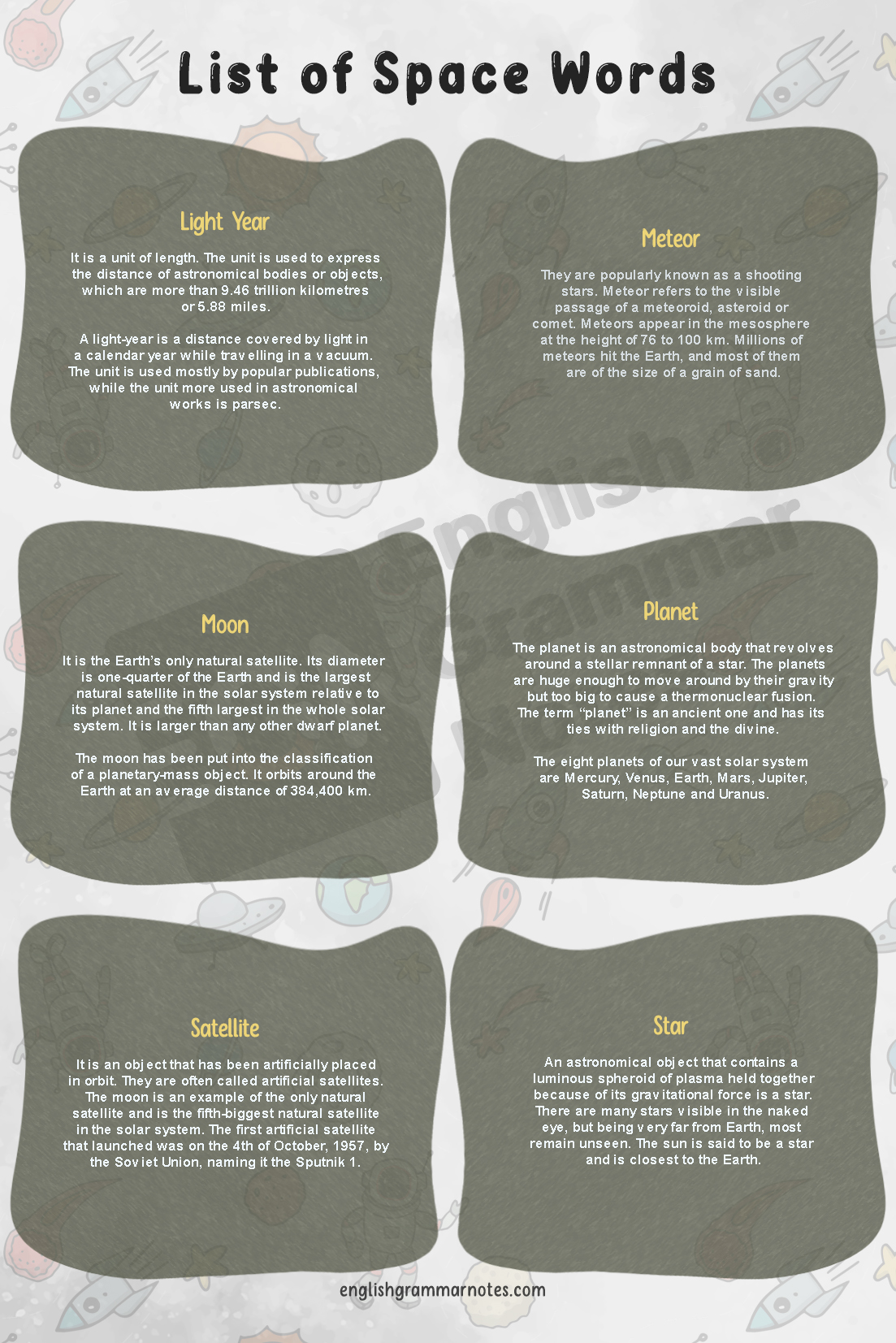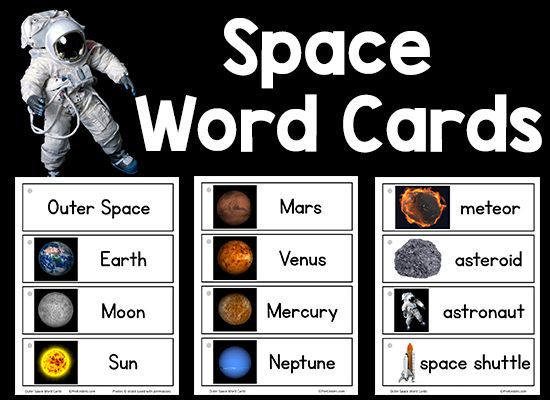Space Words: The name often knows the study of space and space words. As we all know, Astronomy involves the study of stars, asteroids, galaxies, and the solar system. The article helps its readers discover new terms related to outer space and interesting and certain spine-chilling facts.
In this blog, we will provide a thorough description of the different space terms we use in our daily conversations, which might also help the readers to have a stronghold on the language and might help them to draw some eyeballs during a conversation. Astronomy names as well we will draw the list of the space words into attention too.
Study the most important English Vocabulary Words identified by our experts and learn the right vocabulary to use in your day to day conversations
The topic of space or space studies always comes up with several facts that are usually mind-blowing. Some of those certain facts are that the space is completely silent; the hottest planet of all in our solar system is Venus. It records a temperature of 450°C; one million of Earth can fit inside the solar system and there are fewer grains of sand on Earth than the number of stars in the solar system.
List of Space Words
Name of space words
- Asteroid
- Atmosphere
- Celestial
- Comet
- Cosmos
- Eclipse
- Galaxy
- Gravity
- Light-Year
- Meteor
- Meteorite
- Meteoroid
- Moon
- Orbit
- Planet
- Satellite
- Star
- Universe
Description of Space words on the list
Asteroid
They are floating pieces of rocks and minerals. They are a small chunk of rocky materials which orbits around the sun.
They are often described as minor planets. However, if the orbiting object is sensed to be larger, then it is called a planetoid.
Asteroids are almost more than one meter in diameter, which makes them larger than meteoroids. They are made up of the same materials which make the inner part of the solar system, although there are many variations to them which helps us to classify them into three types:
C-type or they are also known as the carbonaceous chondrite asteroids. They consist of silicates and clays and are the most common type of asteroids.
S-type or they are also known as stony asteroids. They are made up of silicates and nickel-iron. Almost one out of five asteroids belong to this type.
M-type or they are also known as metallic asteroids. They mostly consist of nickel and iron.
Most asteroids are found in the belt between Mars and Jupiter. Within our solar system, there are more than 150 million asteroids.
Atmosphere
It is the layers of gas that envelope the planet and is held in a single position due to the planet’s gravitational force. A planet should have a great gravitational force and low temperature to have a good atmosphere.
A stellar atmosphere is present in the outer stars and lays above the opaque photosphere. Stars having low temperatures might have an atmosphere consisting of molecules.
The atmosphere of Earth consists of 78% nitrogen, 21% oxygen, 0.9% argon, 0.04% carbon dioxide and other gases. The layered setup of the atmosphere helps guard off the negative effects of sunlight, ultraviolet radiation, and cosmic rays, which protects the organisms of the planet from genetic disorders.
Celestial
They are naturally occurring objects present in the observable universe. They are also referred to as celestial bodies or celestial objects; in astronomical studies, the terms object and body are used interchangeably.
A celestial body is a tight bound contiguous entity, while a celestial object is a somewhat less tightly bound entity with more than one body or subparts. The list of celestial objects include nebulae, star clusters, planetary systems and galaxies, whereas moons, stars, planets and asteroids are termed celestial bodies.
Comet
It is a small icy body in the solar system that gets warmed and releases gas, creating a process termed outgassing while moving past the sun. The outgassing creates a coma and sometimes a tail. The outgassing is due to the solar radiation and solar wind reacting within the nucleus of the comet. The comet nucleus consists of ice, dust and tiny rock particles, and they range from a few hundred meters to ten kilometres.
Comets have orbits that are highly eccentric and have a huge range of orbital periods. Short-period comets originate in the Kuiper belt, while long-period comets originate in the Oort cloud, which is beyond Neptune. Many comets have been spotted since ancient times.
Cosmos
It is used as an alternative for the term universe. The word implies studying the universe as a more complex and orderly entity. The study of the cosmos has given line to a new science of cosmology, including the cosmology of religion and physiology, which includes entities and physical matters that exist.
Eclipse
An eclipse is referred to as an astronomical event that takes place when an astronomical object or else a spacecraft is obscured for some period by coming into the shadow of another planet or astronomical object or if a third object has come between it and the viewer.
The line at which the three objects fall to form an eclipse is called a syzygy. The term eclipse is often used to refer to the solar eclipse. A binary stars system can do an eclipse if its orbit intersects the viewer’s position.
Galaxy
It is the gravitationally bound system of stars, stellar remnants, interstellar gas, dust and dark matter. The term has been derived from a Greek word that means “milky”. The size of a galaxy ranges from a few hundred million stars to one hundred trillion stars. The stars orbit around the galaxy because of its centre of mass.
Galaxies are categorised based on their visual morphology as being elliptical and spiral. The oldest and most distant galaxy found last in 2016 GN-z11, almost 32 billion light-years away from the planet.
Gravity
It is the virtue of which all the mass objects are attracted to each other.
Gravity gives weight to physical objects on Earth while they cause tides to oceans on the moon. Gravity is often considered to be the reason behind many large structures in the universe. The range of gravity is infinite, but it’s getting weaker as the subjects move away from each other.
During1915, Albert Einstein proposed the general theory of relativity to explain gravity.

Light Year
It is a unit of length. The unit is used to express the distance of astronomical bodies or objects, which are more than 9.46 trillion kilometres or 5.88 miles.
A light-year is a distance covered by light in a calendar year while travelling in a vacuum. The unit is used mostly by popular publications, while the unit more used in astronomical works is parsec.
Meteor
They are popularly known as a shooting stars. Meteor refers to the visible passage of a meteoroid, asteroid or comet. Meteors appear in the mesosphere at the height of 76 to 100 km. Millions of meteors hit the Earth, and most of them are of the size of a grain of sand.
Meteorite
It’s is the part of the meteoroid which hits the planet without getting destroyed while travelling through the atmosphere. Meteorites create huge craters in the Moon or Mars since they have an atmosphere surrounding them.
Meteoroid
According to the International Astronomical Union, a meteoroid is “a solid object moving in interplanetary space, of a size which is smaller than an asteroid and considerably larger than an atom”. Micrometeoroid and interplanetary dust are the classifications of objects smaller than meteoroids. The Minor Planet Centre does not use the term.
Moon
It is the Earth’s only natural satellite. Its diameter is one-quarter of the Earth and is the largest natural satellite in the solar system relative to its planet and the fifth largest in the whole solar system. It is larger than any other dwarf planet.
The moon has been put into the classification of a planetary-mass object. It orbits around the Earth at an average distance of 384,400 km.
Orbit
It is the gravitational curve trajectory of an object. It is a regularly repeating trajectory, but the regularity may be breached. In order to come to a conclusion, Kepler’s law of planetary motion states that planets and satellites have elliptical orbits where the centre of mass is orbited to the point of focus of the ellipse.
Planet
The planet is an astronomical body that revolves around a stellar remnant of a star. The planets are huge enough to move around by their gravity but too big to cause a thermonuclear fusion. The term “planet” is an ancient one and has its ties with religion and the divine.
The eight planets of our vast solar system are Mercury, Venus, Earth, Mars, Jupiter, Saturn, Neptune and Uranus.
Satellite
It is an object that has been artificially placed in orbit. They are often called artificial satellites. The moon is an example of the only natural satellite and is the fifth-biggest natural satellite in the solar system. The first artificial satellite that launched was on the 4th of October, 1957, by the Soviet Union, naming it the Sputnik 1.
Star
An astronomical object that contains a luminous spheroid of plasma held together because of its gravitational force is a star. There are many stars visible in the naked eye, but being very far from Earth, most remain unseen. The sun is said to be a star and is closest to the Earth.

Universe
The term has been derived from a Greek word that means space and time. The universe consists of stars, planets, galaxies and all other forms of energy. According to the Big Bang theory, space and time emerged 12.779 ± 0.021 billion years. The universe has been expanding since then.


